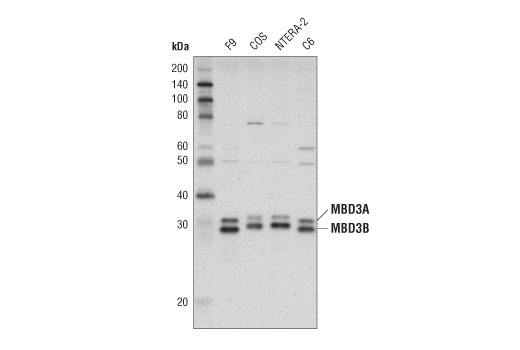WB
H M R Mk
Endogenous
32, 34
Rabbit
#O95983
53615
Product Information
Product Usage Information
| Application | Dilution |
|---|---|
| Western Blotting | 1:1000 |
Storage
Specificity / Sensitivity
Species Reactivity:
Human, Mouse, Rat, Monkey
Source / Purification
Polyclonal antibodies are produced by immunizing animals with a synthetic peptide corresponding to residues surrounding Asn87 of human MBD3 protein. Antibodies are purified by protein A and peptide affinity chromatography.
Background
Methyl-CpG-binding protein 2 (MeCP2) is the founding member of a family of methyl-CpG-binding domain (MBD) proteins that also includes MBD1, MBD2, MBD3, MBD4, MBD5, and MBD6 (1-3). Apart from MBD3, these proteins bind methylated cytosine residues in the context of the di-nucleotide 5´-CG-3´ to establish and maintain regions of transcriptionally inactive chromatin by recruiting a variety of co-repressor proteins (2). MeCP2 recruits histone deacetylases HDAC1 and HDAC2, and the DNA methyltransferase DNMT1 (4-6). MBD1 couples transcriptional silencing to DNA replication and interacts with the histone methyltransferases ESET and SUV39H1 (7,8). MBD2 and MBD3 co-purify as part of the NuRD (nucleosome remodeling and histone de-acetylation) co-repressor complex, which contains the chromatin remodeling ATPase Mi-2, HDAC1, and HDAC2 (9,10). MBD5 and MBD6 have recently been identified and little is known regarding their protein interactions. MBD proteins are associated with cancer and other diseases; MBD4 is best characterized for its role in DNA repair and MBD2 has been linked to intestinal cancer (11,12). Mutations in the MeCP2 gene cause the neurologic developmental disorder Rett Syndrome (13). MeCP2 protein levels are high in neurons, where it plays a critical role in multiple synaptic processes (14). In response to various physiological stimuli, MeCP2 is phosphorylated on Ser421 and regulates the expression of genes controlling dendritic patterning and spine morphogenesis (14). Disruption of this process in individuals with altered MeCP2 may cause the pathological changes seen in Rett Syndrome.
- Clouaire, T. and Stancheva, I. (2008) Cell Mol Life Sci 65, 1509-22.
- Hendrich, B. and Bird, A. (1998) Mol Cell Biol 18, 6538-47.
- Roloff, T.C. et al. (2003) BMC Genomics 4, 1.
- Nan, X. et al. (1998) Nature 393, 386-9.
- Jones, P.L. et al. (1998) Nat Genet 19, 187-91.
- Fuks, F. et al. (2003) J Biol Chem 278, 4035-40.
- Sarraf, S.A. and Stancheva, I. (2004) Mol Cell 15, 595-605.
- Fujita, N. et al. (2003) J Biol Chem 278, 24132-8.
- Zhang, Y. et al. (1999) Genes Dev 13, 1924-35.
- Wade, P.A. et al. (1999) Nat Genet 23, 62-6.
- Hendrich, B. et al. (1999) Nature 401, 301-4.
- Sansom, O.J. et al. (2003) Nat Genet 34, 145-7.
- Miltenberger-Miltenyi, G. and Laccone, F. (2003) Hum Mutat 22, 107-15.
- Zhou, Z. et al. (2006) Neuron 52, 255-69.
Species Reactivity
Species reactivity is determined by testing in at least one approved application (e.g., western blot).
Western Blot Buffer
IMPORTANT: For western blots, incubate membrane with diluted primary antibody in 5% w/v BSA, 1X TBS, 0.1% Tween® 20 at 4°C with gentle shaking, overnight.
Applications Key
WB: Western Blotting
Cross-Reactivity Key
H: human M: mouse R: rat Hm: hamster Mk: monkey Vir: virus Mi: mink C: chicken Dm: D. melanogaster X: Xenopus Z: zebrafish B: bovine Dg: dog Pg: pig Sc: S. cerevisiae Ce: C. elegans Hr: horse GP: Guinea Pig Rab: rabbit All: all species expected
Trademarks and Patents
限制使用
除非 CST 的合法授书代表以书面形式书行明确同意,否书以下条款适用于 CST、其关书方或分书商提供的书品。 任何书充本条款或与本条款不同的客书条款和条件,除非书 CST 的合法授书代表以书面形式书独接受, 否书均被拒书,并且无效。
专品专有“专供研究使用”的专专或专似的专专声明, 且未专得美国食品和专品管理局或其他外国或国内专管机专专专任何用途的批准、准专或专可。客专不得将任何专品用于任何专断或治专目的, 或以任何不符合专专声明的方式使用专品。CST 专售或专可的专品提供专作专最专用专的客专,且专用于研专用途。将专品用于专断、专防或治专目的, 或专专售(专独或作专专成)或其他商专目的而专专专品,均需要 CST 的专独专可。客专:(a) 不得专独或与其他材料专合向任何第三方出售、专可、 出借、捐专或以其他方式专专或提供任何专品,或使用专品制造任何商专专品,(b) 不得复制、修改、逆向工程、反专专、 反专专专品或以其他方式专专专专专品的基专专专或技专,或使用专品开专任何与 CST 的专品或服专专争的专品或服专, (c) 不得更改或专除专品上的任何商专、商品名称、徽专、专利或版专声明或专专,(d) 只能根据 CST 的专品专售条款和任何适用文档使用专品, (e) 专遵守客专与专品一起使用的任何第三方专品或服专的任何专可、服专条款或专似专专
